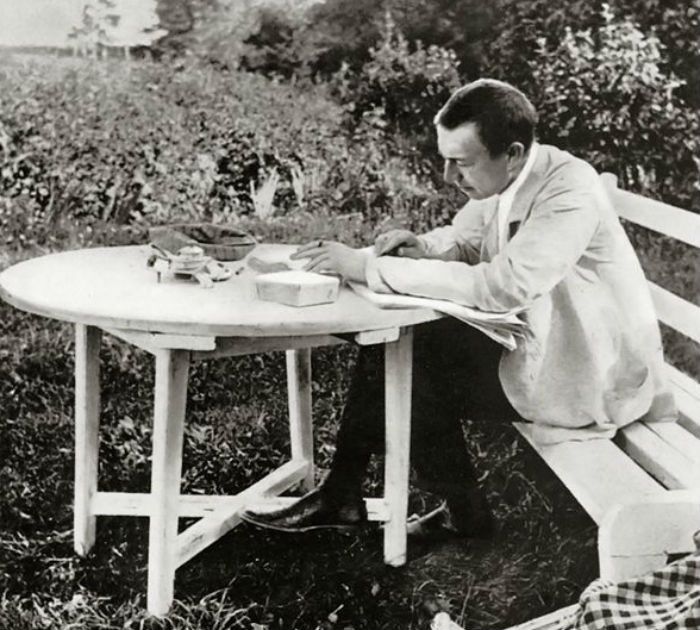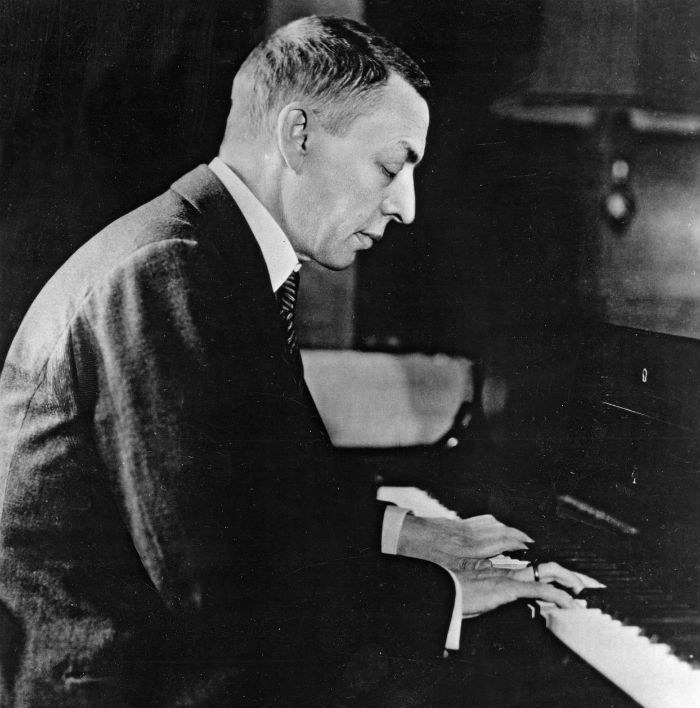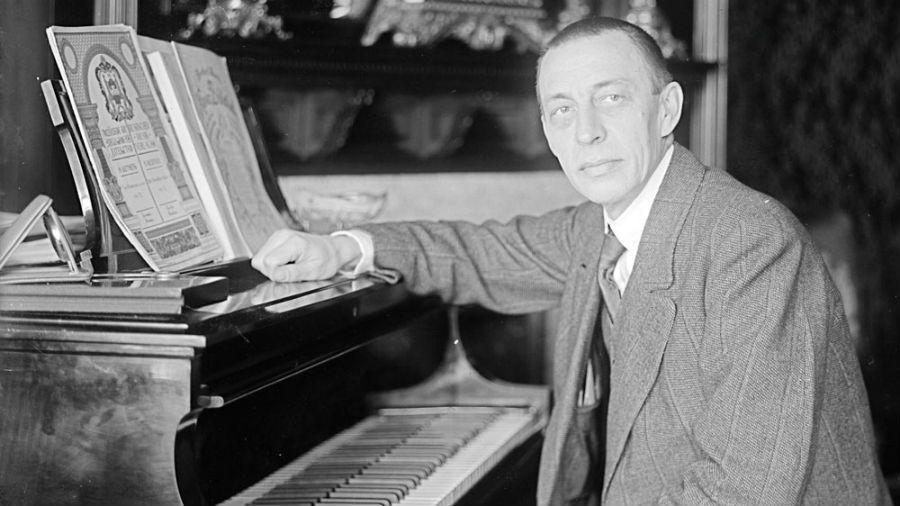Described as a “six and a half foot scowl” by Igor Stravinsky, Sergei Rachmaninoff (born April 1st, 1873) rose to fame at age 18 with his first Piano Concerto. Not only was he a prolific composer; in fact, he was also a virtuoso-like pianist.
Rachmaninoff’s repertoire mainly consisted of 19th Century standard virtuoso works and music by Bach, Beethoven, Borodin, Debussy, Grieg, Liszt, Mendelssohn, Mozart, Schubert, Schumann and Tchaikovsky. Definition characterized his playing: his textures were crystal clear, a characteristic he shared with Josef Hofmann, to whom he dedicated his third piano concerto.
Below are seven interesting facts about the composer and virtuoso:
Feel free to Subscribe to Our YouTube Channel if you like this video!
Just like Anton Rubinstein, his hands were huge
Rachmaninoff looked up to Anton Rubinstein as a model and, in particular, he singled out out for praise Rubinstein’s rendition of Beethoven’s Appassionata and Chopin’s Funeral March Sonata.”[His playing] gripped my whole imagination and had a marked influence on my ambition as a pianist,” he told his biographer Oscar von Riesemann.
Just like Rubinstein, Rachmaninoff had very large hands: in fact, he could span 12 piano keys from the tip of his little finger to the tip of his thumb. This is why less-endowed performers find it difficult to play some of his pieces.
The Fear Surrounding his Piano Concerto n.3

Many pianists fear Rachmaninoff’s Piano Concerto n.3, deemed one of the most technically challenging concertos in the classical repertoire: Joseph Hofmann, to whom the work was dedicated, never performed it in public. It wasn’t for him, he said. Gary Graffman lamented the fact he had not learned the concert as a student, where he was “too young to know fear.” The concerto had its first performance on November 28th, 1909, by Rachmnaninoff himself and the now-defunct New York Symphony Society. Several weeks later, Gustav Mahler conducted it. “At that time Mahler was the only conductor whom I considered worthy to be classed with Nikisch. He devoted himself to the concerto until the accompaniment, which is rather complicated, had been practiced to perfection, although he had already gone through another long rehearsal. According to Mahler, every detail of the score was important — an attitude too rare amongst conductors…” Rachmaninoff told to his biographer Oscar von Riesemann.
The Self-appointed “last romantic composer”
Glenn Quilty, who had the privilege to study with Rachmaninoff and who dedicated his Victorian Concerto to him, interviewed the composer at the Ansonia Hotel in New York. On that occasion Rachmaninoff defined himself as the last romantic composer, who reflected the philosophy of Old Russia “with its overtones of suffering and unrest, its pastoral but tragic beauty, its ancient and enduring glory.” His harmonic arrangement and tonalities were, to him, in the genre “of flowing, lush effects and illuminated vista viewed from a romantic point.” He saw himself as less incisive and less sharp than Schönberg and Hindemith. He wished to encompass the listener in warmth and to transport him to an ideal planet. That ideal, however, did not equal utopia “there is an undercurrent sorrow in my work,” he told Quilty. Rachmaninoff deemed Romantic music timeless, as it reflected the warmth and depth of compassion in human nature: by contrast, he predicted that the bitter tonalities of modern music would vanish even though they reflected the times they were composed in.
The Ubiquitous Sound of Bells
Rachmaninoff’s maternal grandmother, who had a very active role in the composer’s upbringing, regularly took him to Russian Orthodox service: there, he was exposed to liturgical chants and church bells, which played a deep influence in many of his compositions. In fact, by using widely spaced chords, Rachmaninoff reproduced the sound of the bells. The variety of the bell sounds he managed to include in his work is noteworthy: The Bells, op. 35 evokes sleigh bells, wedding bells, alarm bells and church bells. Other works include gentle oscillations, descant figurations, bold punctuating strokes, reverberant clanging, and vast pendulum-like swings. Elegie op. 3 n. 1 has oscillating quaver bells (bars 4iff ). In the third section of the Prelude in D Major op. 23 n.4, echoing, glockenspiel-like bells make an appearance (bars 53ff). The Prelude in B minor op.32 no. 10 presents a melody punctuated with bell-like tolling (bars iff) and, in the central section, repeated chords simulate the reverberant clangour of massive iron bells (bars 22ff ).
The Concerto n.2 is a pivotal composition in Rachmaninoff’s career (and popular culture)
After the poor reception of his Symphony n.1 (1897) where composer César Cui likened it to a depiction of the ten plagues of Egypt, suggesting it would be admired by the “inmates” of a music conservatory in hell, Rachmaninoff fell into a deep depression, which lasted for almost three years. During that period of time his musical production and composition activity almost ceased. However, In 1900, he began a course of autosuggestive therapy with psychologist Nikolai Dahl, an amateur musician himself. Thanks to the therapy, he began to recover his confidence and, one year later, the Piano Concerto n. 2 saw the light. At the premiere, Rachmaninoff himself was soloist and the piece was received enthusiastically.
Now one of the most popular pieces in Rachmaninoff’s repertoire, The Piano Concerto n. 2 is heavily featured in popular culture and has been quoted also in pop music compositions: as far as the derivative works are concerned, the adagio theme appears in the ballad All By Myself: author Eric Carmen, in fact, explained that Rachmaninoff was “his favourite music.” The Muse’s 2001 song Space Dementia has a lyric line —and tear us apart and make us meaningless again— that follows the melody of the first movement (moderato).
Horowitz could pull his Piano Concerto n. 3 off
After migrating to the United States in 1918, the Rachmaninoffs tried to recreate the atmosphere of Ivanovka, their Russian estate, in their US house: they entertained Russian guests, employed Russian servants and observed old Russian customs. He strove to reclaim the lost world of pre-revolutionary Russia, and, as such, he sought the friendship and company of some Russian musical luminaries. He befriended Vladimir Horowitz in 1928, four days before the latter’s debut at Carnegie Hall playing Tchaikovsky’s first Piano Concerto. Rachmaninoff had heard positive reviews of Horowitz playing his own third piano concerto and asked to accompany Horowitz in a performance of it. Horowitz himself revered Rachmaninoff “[Rachmaninoff was] the musical god of my youth … To think that this great man should accompany me in his own Third Concerto … This was the most unforgettable impression of my life! This was my real debut!” Horowitz said. After the concert, Rachmaninoff offered constructive criticism to the pianist, telling him to perfect the cadenza of his interpretation of Tchaikovsky’s Piano Concerto. However, he had nothing but praise for Horowitz’s rendition of his own Third Piano Concerto. “he swallowed it whole … he had the courage, the intensity, the daring”
The two men remained supportive of each other’s work, and, in 1940 Horowitz fused, with Rachmaninoff’s consent, his original 1913 and his 1931 revised version of his Second Piano Sonata.
The “Culminating Point” theory
When it came to interpreting a piece of music, Rachmaninoff theorized that every piece of music had a culminating point and that, regardless of where that particular point is within the piece, the performer had to know how to approach it with precision and calculation—otherwise the construction and execution of the piece would feel disjointed and “fuzzy”. As for where that point is, the composition itself determines the culmination:it can be at the end or in the middle, and be either loud or soft. Rachmaninoff himself learned this practice from Feodor Chaliapin, a close friend. “This moment must arrive with the sound and sparkle of a ribbon snapped at the end of a race—it must seem like a liberation from the last material object, the last barrier between truth and its expression,” Rachmaninoff explained. As an example of a “culminating point,” the end of the third piano concerto might be quite fitting.


